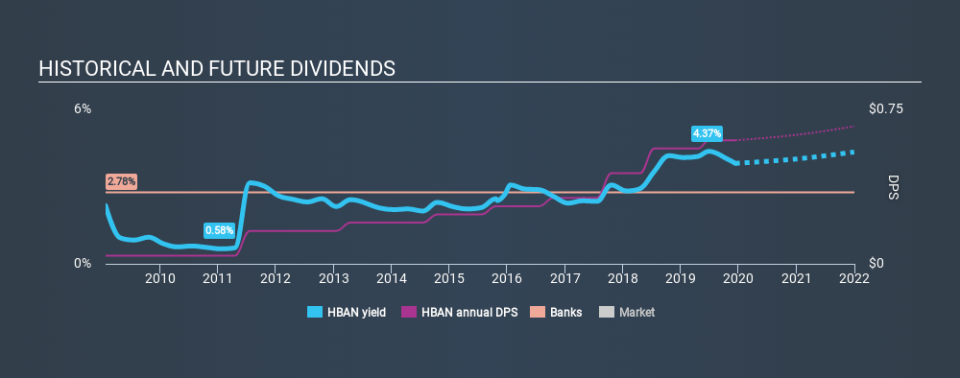Does Huntington Bancshares Incorporated (NASDAQ:HBAN) Have A Place In Your Dividend Portfolio?

Today we'll take a closer look at Huntington Bancshares Incorporated (NASDAQ:HBAN) from a dividend investor's perspective. Owning a strong business and reinvesting the dividends is widely seen as an attractive way of growing your wealth. Yet sometimes, investors buy a popular dividend stock because of its yield, and then lose money if the company's dividend doesn't live up to expectations.
A high yield and a long history of paying dividends is an appealing combination for Huntington Bancshares. We'd guess that plenty of investors have purchased it for the income. The company also returned around 3.0% of its market capitalisation to shareholders in the form of stock buybacks over the past year. There are a few simple ways to reduce the risks of buying Huntington Bancshares for its dividend, and we'll go through these below.
Explore this interactive chart for our latest analysis on Huntington Bancshares!
Payout ratios
Dividends are typically paid from company earnings. If a company pays more in dividends than it earned, then the dividend might become unsustainable - hardly an ideal situation. Comparing dividend payments to a company's net profit after tax is a simple way of reality-checking whether a dividend is sustainable. In the last year, Huntington Bancshares paid out 44% of its profit as dividends. A medium payout ratio strikes a good balance between paying dividends, and keeping enough back to invest in the business. Besides, if reinvestment opportunities dry up, the company has room to increase the dividend.
Remember, you can always get a snapshot of Huntington Bancshares's latest financial position, by checking our visualisation of its financial health.
Dividend Volatility
From the perspective of an income investor who wants to earn dividends for many years, there is not much point buying a stock if its dividend is regularly cut or is not reliable. Huntington Bancshares has been paying dividends for a long time, but for the purpose of this analysis, we only examine the past 10 years of payments. During this period the dividend has been stable, which could imply the business could have relatively consistent earnings power. During the past ten-year period, the first annual payment was US$0.04 in 2009, compared to US$0.60 last year. Dividends per share have grown at approximately 31% per year over this time.
It's rare to find a company that has grown its dividends rapidly over ten years and not had any notable cuts, but Huntington Bancshares has done it, which we really like.
Dividend Growth Potential
Dividend payments have been consistent over the past few years, but we should always check if earnings per share (EPS) are growing, as this will help maintain the purchasing power of the dividend. It's good to see Huntington Bancshares has been growing its earnings per share at 12% a year over the past five years. Earnings per share have been growing at a good rate, and the company is paying less than half its earnings as dividends. We generally think this is an attractive combination, as it permits further reinvestment in the business.
Conclusion
To summarise, shareholders should always check that Huntington Bancshares's dividends are affordable, that its dividend payments are relatively stable, and that it has decent prospects for growing its earnings and dividend. Firstly, we like that Huntington Bancshares has a low and conservative payout ratio. That said, we were glad to see it growing earnings and paying a fairly consistent dividend. Overall, we think there are a lot of positives to Huntington Bancshares from a dividend perspective.
Companies that are growing earnings tend to be the best dividend stocks over the long term. See what the 16 analysts we track are forecasting for Huntington Bancshares for free with public analyst estimates for the company.
Looking for more high-yielding dividend ideas? Try our curated list of dividend stocks with a yield above 3%.
If you spot an error that warrants correction, please contact the editor at editorial-team@simplywallst.com. This article by Simply Wall St is general in nature. It does not constitute a recommendation to buy or sell any stock, and does not take account of your objectives, or your financial situation. Simply Wall St has no position in the stocks mentioned.
We aim to bring you long-term focused research analysis driven by fundamental data. Note that our analysis may not factor in the latest price-sensitive company announcements or qualitative material. Thank you for reading.

 Yahoo Finance
Yahoo Finance 
